
Selma is a town in Johnston County, North Carolina, United States. In 2010, the population was 6,073, and as of 2018 the estimated population was 6,913. Selma is part of the Raleigh-Durham-Cary Combined Statistical Area. The area has a population over 1.7 million residents, though the town of Selma is able to maintain its rural character. The Everitt P. Stevens House, located in Selma, was the site of the last Grand Review of the Confederate Army held on April 6, 1865, after its defeat at the Battle of Bentonville.

Mebane is a city located mostly in Alamance County, North Carolina, United States, and partly in Orange County. The town was named for Alexander Mebane, an American Revolutionary War general and member of the U.S. Congress. It was incorporated as "Mebanesville" in 1881, and in 1883 the name was changed to "Mebane". It was incorporated as a city in 1987. The population as of the 2020 census was 17,797.
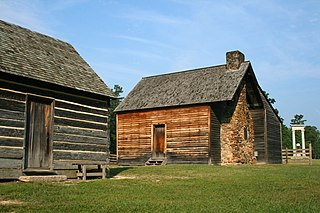
Bennett Place is a former farm and homestead in Durham, North Carolina, which was the site of the last surrender of a major Confederate army in the American Civil War, when Joseph E. Johnston surrendered to William T. Sherman. The first meeting saw Sherman agreeing to certain political demands by the Confederates, which were promptly rejected by the Union cabinet in Washington. Another meeting had to be held to agree on military terms only, in line with Robert E. Lee’s recent surrender to Ulysses S. Grant. This effectively ended the war.

Stagville Plantation is located in Durham County, North Carolina. With buildings constructed from the late 18th century to the mid-19th century, Stagville was part of one of the largest plantation complexes in the American South. The entire complex was owned by the Bennehan, Mantack and Cameron families; it comprised roughly 30,000 acres (120 km2) and was home to almost 900 enslaved African Americans in 1860.
Durham House may refer to:

The Old North Carolina Mutual Life Insurance Company Building, also known as the Mechanics and Farmers Bank Building, is an office building at 114-116 West Parrish Street in downtown Durham, North Carolina. It formerly served as the headquarters for the North Carolina Mutual Life Insurance Company, which was formerly one of the nation's largest companies founded and owned by African-Americans. The building was declared a National Historic Landmark in 1975.

This list includes properties and districts listed on the National Register of Historic Places in Durham County, North Carolina. Click the "Map of all coordinates" link to the right to view an online map of all properties and districts with latitude and longitude coordinates in the table below.
T.S. Christian is the name of one or more builders of significant structures that are listed in the U.S. National Register of Historic Places in Pennsylvania and in North Carolina.
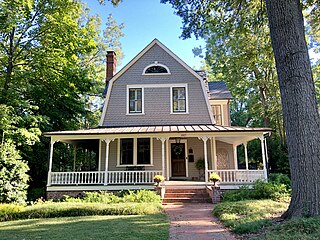
The Bassett House is a historic home located at 1017 W. Trinity Ave. in Durham, Durham County, North Carolina. It was built in 1891 by local contractor T.S. Christian, and is a Shingle Style dwelling.

The American Tobacco Historic District is a historic tobacco factory complex and national historic district located in Durham, Durham County, North Carolina. The district encompasses 14 contributing buildings and three contributing structures built by the American Tobacco Company and its predecessors and successors from 1874 to the 1950s. Located in the district is the separately listed Italianate style W. T. Blackwell and Company building. Other notable contributing resources are the Romanesque Revival style Hill Warehouse (1900), Washington Warehouse (1902–07), the Lucky Strike Building (1901–02), and Reed Warehouse; Noell Building ; Power Plant and Engine House (1929–39); and the Art Moderne style Fowler (1939) Strickland (1946) and Crowe (1953) buildings.
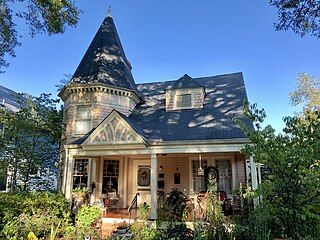
Crowell House is a historic home located at Durham, Durham County, North Carolina. It was built in 1891 by local contractor T.S. Christian, and is a two-story, Shingle Style dwelling.
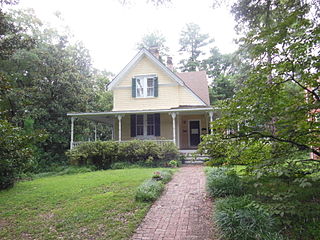
Pegram House is a historic home located at Durham, Durham County, North Carolina. It was built in 1891 by local contractor T.S. Christian, and is a two-story, Shingle Style dwelling. It features a wraparound porch.
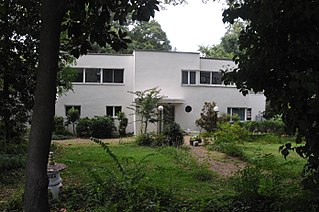
Dillard-Gamble Houses are two historic homes located at Durham, Durham County, North Carolina. One house is in the Colonial Revival style and the other is in the International Style.

Kinchen Holloway House, also known as Guess Mill House, is a historic home located at Durham, Durham County, North Carolina. It was built about 1870, and is a two-story, three-bay, frame I-house with a one-story, gable-roof rear ell. It was built by Kinchen Holloway, a farmer and miller.

Durham Hosiery Mill is a historic textile mill complex located at Durham, Durham County, North Carolina. It includes seven contributing brick buildings in the complex. The original Durham Hosiery Mill was built in 1902, and consists of a four-story main building with a six-story Romanesque Revival-style tower in front; engine, boiler, and heater houses attached at the rear, and a one-story dye house. The main building was expanded with a two-story annex in 1904, and a three-story annex in 1906. Other buildings include the triangular Annex No. 1 (1912) and a three-story brick finishing building. By 1910, the Durham Hosiery Mills Corporation was the largest manufacturer of cotton hosiery in the world. The mill was abandoned in 1922.
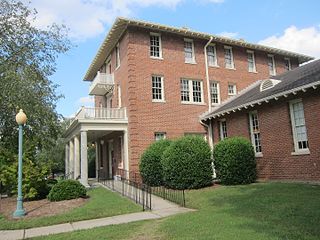
North Durham County Prison Camp, also known as Durham County Tuberculosis Sanatorium, is a historic prison and sanatorium located at Durham, Durham County, North Carolina. It was built in 1925, and is a three-story, T-shaped, Italianate style brick building. The building measures 232 feet long and has 17,000 square feet of floorspace. It features a three-bay, Tuscan order portico in the Colonial Revival style. The building was originally constructed to serve as a prison facility. It housed a prison between 1925 and 1938, was converted for use as a tuberculosis sanatorium beginning in 1944 and continued this function until 1953. It then housed WTVD Television Corporation until 1979.

Trinity Historic District, also called Trinity Park, is a national historic district and residential area located near the East Campus of Duke University in Durham, North Carolina. The district encompasses 751 contributing buildings in a predominantly residential section of Durham. They were built between the 1890s and 1960 and include notable examples of Queen Anne and Bungalow / American Craftsman style architecture. Located in the district are the separately listed "Faculty Row" cottages: the Bassett House, Cranford-Wannamaker House, Crowell House, and Pegram House. Other notable buildings include the George W. Watts School (1917), Julian S. Carr Junior High School (1922), Durham High School (1923), Durham Alliance Church (1927), Trinity Avenue Presbyterian Church (1925), Watts Street Baptist Church (1925), Great A & P Tea Company (1927-1929), Grace Lutheran Church, and the former Greek Orthodox Community Church.
Smith-Williams-Durham Boarding House was a historic boarding house located at Hendersonville, Henderson County, North Carolina. It was built about 1909, and was raised to two-stories and remodeled in 1918. It was a rambling frame former dwelling with Classical Revival style design elements. It had a low hipped roof with extended and bracketed eaves and a single tiered wraparound porch. It has been demolished.

Asheboro Hosiery Mills and Cranford Furniture Company Complex, also known as Cranford Industries and National Chair Company, is a historic textile mill and furniture factory complex located at Asheboro, Randolph County, North Carolina. The complex includes three brick industrial buildings erected from 1917 through the 1940s and the Cranford Industries Office, constructed in 1925. Also on the property are the contributing Cranford Industries Smokestack built in the 1950s and a lumber shed erected in the late-1950s.

Immaculate Conception Catholic Church & Immaculata Catholic School are a Catholic parish church and parochial school run by the Order of Friars Minor in downtown Durham, North Carolina. The church and school are located in the Burch Avenue Historic District. Immaculate Conception is the oldest Catholic congregation in Durham, and the affiliated school was the city's first Catholic school.





















